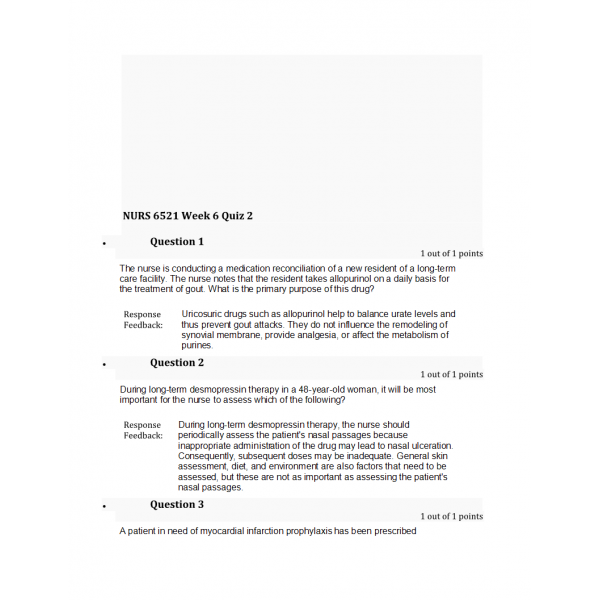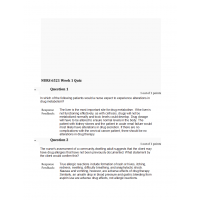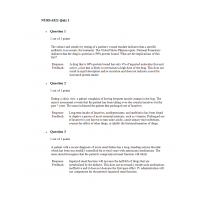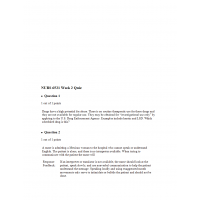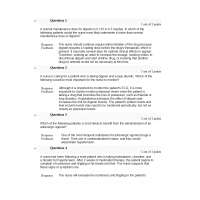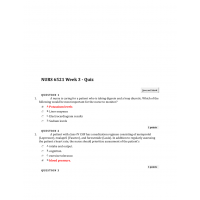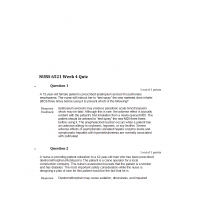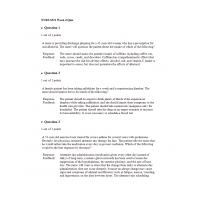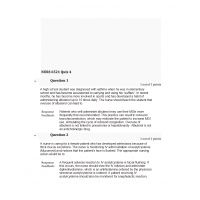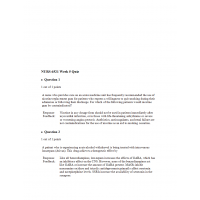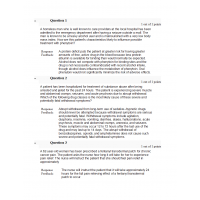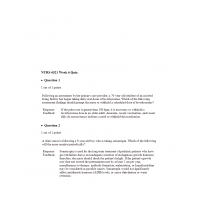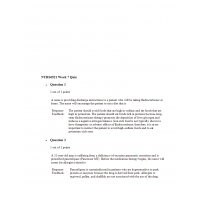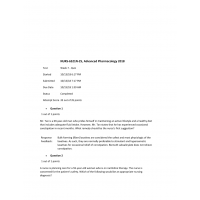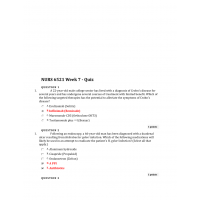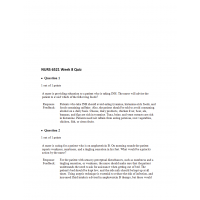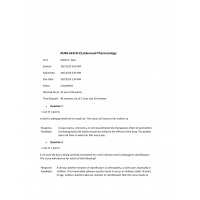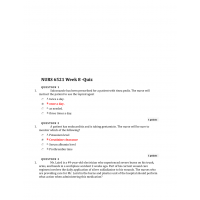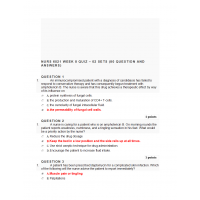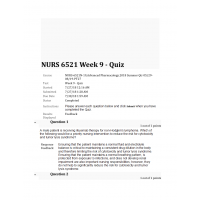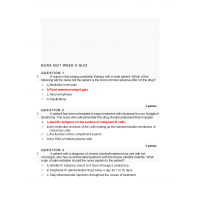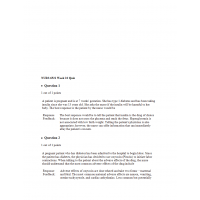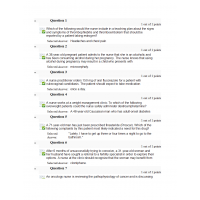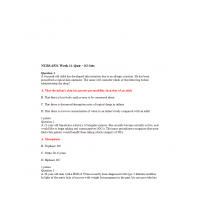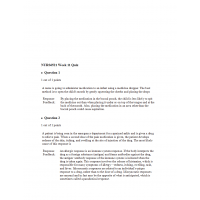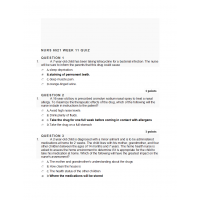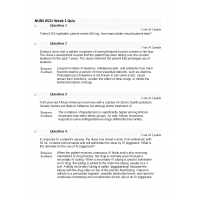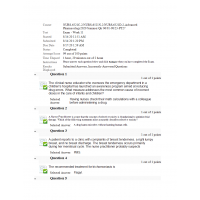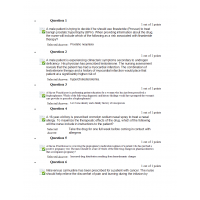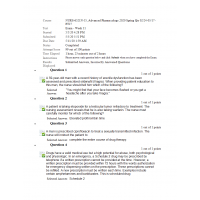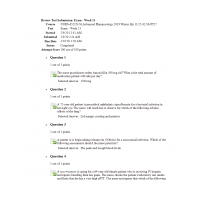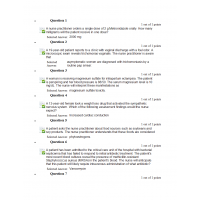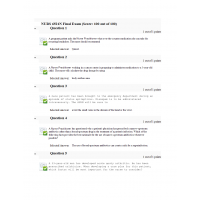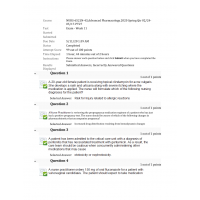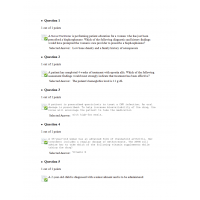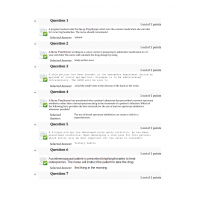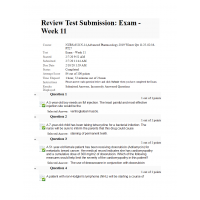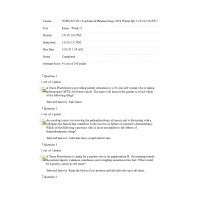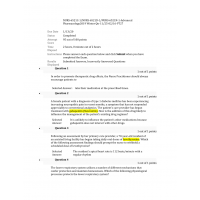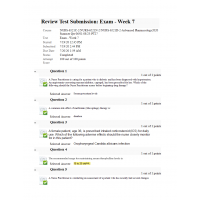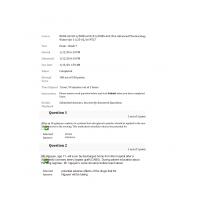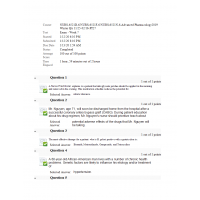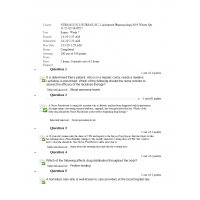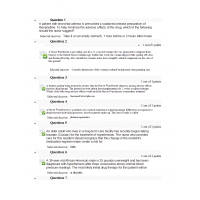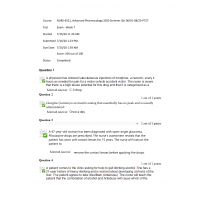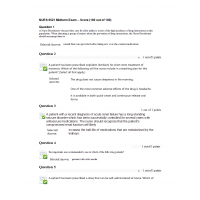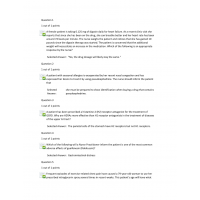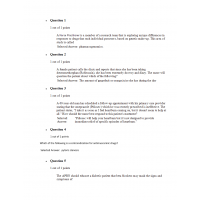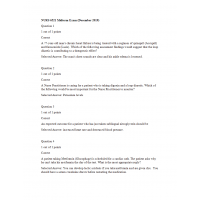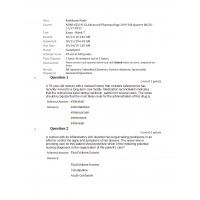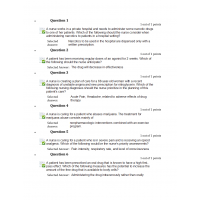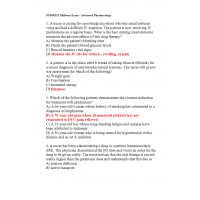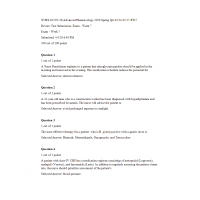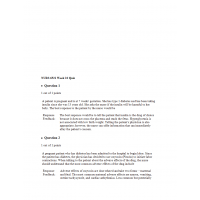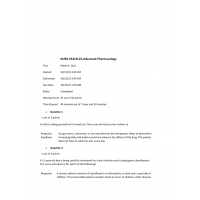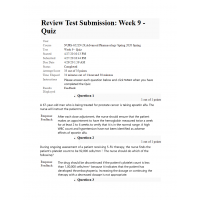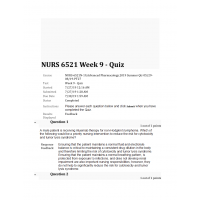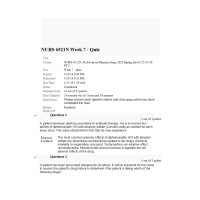NURS 6521N Week 6 Quiz Answers
1. The nurse is conducting a medication reconciliation of a new resident of a long-term care facility. The nurse notes that the resident takes allopurinol on a daily basis for the treatment of gout. What is the primary purpose of this drug?
2. During long-term desmopressin therapy in a 48-year-old woman, it will be most important for the nurse to assess which of the following?
3. A patient in need of myocardial infarction prophylaxis has been prescribed sulfinpyrazone for gout. Which of the following will the nurse monitor the patient most closely for?
4. A 40-year-old woman with a diagnosis of fibromyalgia has been prescribed cyclobenzaprine (Flexeril) as an adjunct to her existing drug regimen. What nursing diagnosis should the nurse prioritize when updating the nursing care plan for this patient?
5. To minimize the risk of adverse effects of glucagon when given to an unconscious diabetic patient, as the patient regains consciousness, the nurse should
6. A 49-year-old woman has been diagnosed with myalgia. The physician has recommended aspirin. The patient is concerned that the aspirin will upset her stomach. The nurse will encourage the patient to
7. Which of the following would be the most important safety-related instruction for a nurse to give to a patient taking baclofen (Lioresal)?
8. A female patient with a diagnosis of type 1 diabetes mellitus has been experiencing increasing neuropathic pain in recent months, a symptom that has not responded appreciably to conventional analgesics. The patient's care provider has begun treatment with gabapentin (Neurontin). How is the addition of this drug likely to influence the management of the patient's existing drug regimen?
9. A patient receives 25 units of NPH insulin at 7.AM. At what time of day should the nurse advise the patient to be most alert for a potential hypoglycemic reaction?
10. A patient is taking gabapentin (Neurontin) for spasticity associated with multiple sclerosis. Which of the following should be the priority for monitoring?
11. A nurse is instructing a patient who was recently diagnosed with multiple sclerosis about dantrolene (Dantrium). The patient is a 38-year-old-male and the foreman for a construction company. In order to minimize one important adverse effect of the drug, the nurse will give the patient which of the following instructions?
12. A 66-year-old woman has experienced a significant decline in her quality of life as a result of worsening rheumatoid arthritis. Her physician has prescribed etanercept and the nurse is responsible for facilitating this new aspect of the patient's drug regimen. This will involve the administration of
13. Following an assessment by her primary care provider, a 70-year-old resident of an assisted living facility has begun taking daily oral doses of levothyroxine. Which of the following assessment findings should prompt the nurse to withhold a scheduled dose of levothyroxine?
14. A nurse is assessing a patient who has come to the emergency department complaining of back spasms. The patient states that he has a history of opioid addiction and does not want to take any drug that “puts me at risk of becoming physically dependent.” Which of the following medications would the nurse question, if ordered?
15. A 33-year-old man has developed acute gouty arthritis. He has been prescribed colchicine. When developing a care plan for this patient, which factor will be most important for the nurse to consider?
16. A clinic nurse is following a 9-year-old boy who is taking somatropin. Which of the following will the nurse monitor periodically?
17. A 34-year-old male patient is prescribed methimazole (MMI). The nurse will advise him to report which of the following immediately?
18. A nurse will instruct a patient taking allopurinol to take each dose
19. A nurse is developing a care plan for a patient who has multiple sclerosis. An expected outcome for the patient who is receiving glatiramer would be a decrease in
20. A patient with type 1 diabetes has been admitted to the hospital for orthopedic surgery and the care team anticipates some disruptions to the patient's blood glucose levels in the days following surgery. Which of the following insulin regimens is most likely to achieve adequate glycemic control?
21. A 13-year-old patient has juvenile arthritis. He has recently had oral surgery and was told by the surgeon to take aspirin for the pain. The nurse will monitor for which of the following?
22. A 70-year-old woman who is on long-term ibuprofen therapy for osteoarthritis has returned to the clinic for her regular 6-month visit. In the last couple of months, she has been having increasing periods of abdominal pain. The nurse suspects that this pain may be related to
23. A 65-year-old woman has an advanced form of rheumatoid arthritis. Her treatment includes a regular dosage of methotrexate. The nurse will advise her to take which of the following vitamin supplements while taking the drug?
24. A male patient with a diagnosis of relapsing-remitting multiple sclerosis is in the clinic to discuss with the nurse the possibility of self-administration of glatiramer. During the patient education session for self-administration, the nurse will emphasize
25. A patient with diabetes has had a cough for 1 week and has been prescribed a cough syrup (an expectorant). What special instructions should the nurse include in the patient teaching for this situation?
26. A nurse has been invited to speak to a support group for persons with movement disorders and their families. Which of the following statements by the nurse addresses the chronic nature of these diseases and the relevant drug therapies?
27. A nurse is caring for a patient who has been diagnosed with hypothyroidism. Levothyroxine (Synthroid) has been prescribed. Before the drug therapy is started, the nurse will assess for which of the following?
28. A 32-year-old female patient is taking tizanidine (Zanaflex) for spasticity related to her multiple sclerosis. The nurse will inform the patient and her husband that the adverse effect that poses the greatest safety risk to the patient is
29. A diabetic patient being treated for obesity tells the nurse that he is having adverse effects from his drug therapy. The patient has been taking dextroamphetamine for 2 weeks as adjunct therapy. Which of the following adverse effects would need the nurse's immediate attention?
30. A 43-year-old woman was diagnosed with multiple sclerosis 2 years ago and has experienced a recent exacerbation of her symptoms, including muscle spasticity. Consequently, she has been prescribed Dantrolene (Dantrium). In light of this new addition to her drug regimen, what teaching point should the woman's nurse provide?
| Institution & Term/Date | |
| Term/Date | Walden University |
NURS 6521N Week 6 Quiz 2 - Question and Answers
- Product Code: 2019
- Availability: In Stock
-
$12.00
Related Products
NURS 6521N Week 10 Quiz
$12.00
NURS 6521N Week 9 Quiz 1
$12.00
Tags: NURS 6521N

